Maximise margins with your own veg box scheme

Conventional and organic vegetable box schemes have increased in popularity significantly over recent years and sales topped £100 million last year, according to the Soil Association. Such direct retail links between producer and consumer now represent around 2% of UK grocery market activity.
Most box schemes are organised around the delivery of a weekly supply of locally-harvested vegetables, direct to the customer’s home, or to a neighbourhood pickup point.
Some farms grow all the produce for their customers’ boxes, but most will supplement shortages or provide more variety, by buying in from other local producers. Schemes which involve purchases from further afield, including imports, usually include a commitment as to origin.
What are the advantages for the farmer?
By operating the supply chain yourself, you hang on to those profit margins which would normally go to the wholesaler or commercial buyer.
Once you have established a stable customer base, there is potential for tailoring your crop programme to fill your veg boxes, rather than growing speculatively for other direct retail outlets. In the same way, income and cash flow are potentially more predictable.
Risk is spread over a number of customers and a larger range of crops.
You don’t have to worry about standardising your vegetables to fit the packaging requirements of the commercial market, or growing a crop which goes to waste because it is no longer required by the commercial buyer.
If existing plant and premises are used, capital outlay is relatively low.
You have the satisfaction of being part of an expanding network of local food production.
You are also directly in touch with your customers, whose starting point is typically an enthusiasm about fresh, local food. At the same time, the public do not need to have access to your farm, unless this is part of your marketing and distribution plan.
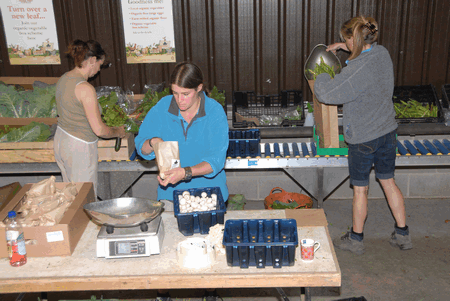
What are the disadvantages?
Your customer expects variety. The growing, harvesting, and storage of a range of vegetables of sufficient quality and quantity can be challenging and labour-intensive. Maintaining year-round supply is also difficult, with a few schemes electing to shut down during the April to June “hungry gap”.
Organising and packing your boxes takes time, depending on how customised your box contents are.
Liaison with individual customers also requires time, and attention to detail.
Fuel and staffing costs involved in delivery can be unacceptably high, depending on your location and whether you offer a doorstep or pick-up service.
How much land would I need?
As a benchmark, The Organic Vegetables Studies Survey found that 1ha of land produces enough for 60 veg boxes. Conventional farmers would typically expect a higher yield.
How about buildings?
You will need clean, pest-free storage facilities and packing shed.
Equipment?
Polytunnels will extend season and variety. Cold storage may be necessary, although check the ADAS Wales report for alternative store solutions (see “Useful links” box). For larger schemes, a conveyer belt would make your packing operation more efficient.
And staffing?
The Organic Vegetables survey estimates that the packing and delivery involved in a 10-box scheme would take one full-time and one part-time worker. There are staffing economies to be made if the scheme is combined with other retail activities, such as farmers’ markets and farm shops.
Can I get financial help?
Contact Business Link for advice on available funding.
How do I start my scheme?
Do some research, starting by looking carefully at where you are. A local box scheme typically serves customers within a 10-15 mile radius.
Is there already a scheme operating in your area? Are you near concentrations of population, which would make your marketing and distribution more efficient? Or do you want to develop a smaller network of local customers and outlets?
Test out demand by talking to local groups about your idea. Put leaflets through doors. Take a stall at a local farmers’ market and canvas your customers. Contact local press and radio, and food trade organisations. And look into the possibility of tourists to the area using your scheme. Look at what other veg box schemes do.
If you think you will have enough interest, you may want to kick-start demand by offering an introductory box to potential regulars. And bear in mind that most schemes grow through personal recommendation. Some offer incentives to existing customers to introduce a friend.
Healthy eating campaigns
Vegetable boxes do encourage households to adopt healthier diets. Since January 2008 local health and government authorities have been issued with new anti-obesity directives.
Get in touch with local schools, GP surgeries and workplaces, to see if you can collaborate on a healthy eating campaign.
Some box schemes, such as Bee-Organics, distribute through a local school, with the PTA collecting a commission, which in this case goes towards the sports fund. In Newquay, the Trevilley Farm scheme now delivers to two nursery schools, where the children use their weekly veg box for their cooking and learning programme.
What goes into the veg box?
Most box schemes include staples such as potatoes, carrots and onions, and a selection of seasonal vegetables. Boxes currently vary in price between £7.50 and £20.00.
The Soil Association suggests three sizes of box, to cater for different households. It is well worth looking at other schemes to get an idea of what to put in your box. You can find these listed on the vegbox-recipes website.
Note that some schemes cater for preference, while others are totally standardised. Take time to arrange contents so they look attractive and appetising.
Legislation?
Food Safety, Health and Safety, and Weights and Measures, are the main areas of legislation that you need to be aware of before starting your scheme.
There are some environmental health registration exemptions for farmers selling primary produce direct to the end consumer, but as with all activities where food is involved, you should always check with your local environmental health office first. They will talk you through food safety issues and how you can ensure that you are complying with the law.
Likewise, notify Trading Standards. Some of your produce can be sold by count, otherwise by weight. Your weighing equipment will be inspected periodically.
As a vegetable producer, you are subject to the 2006 food hygiene regulations, which will require you to follow basic procedures to avoid contamination when produce is in the ground or in storage. See the Food Safety leaflet www.food.gov.uk.
Insurance
You will need public liability insurance, and if you have employees, employer liability insurance.
Delivery
In view of rising fuel costs, there are careful decisions to be made as to whether you are a home delivery scheme, or one which uses a pick up system. If delivering to collection points, make sure that the boxes can be deposited in a cool area.
How do I keep my customers?
Building a satisfied and loyal customer base is fundamental to a successful veg box scheme. Most schemes use newsletters and websites.
Explaining shortages and crop failures as well as new varieties and developments can help customers identity with the process. Some schemes do farm walks, and several offer recipes for the vegetables that are delivered that week.
Vegbox offers its business subscribers listing and access to a database of recipes. It has also carried out a comprehensive survey of veg box customers, giving a good indication of why households stay (and leave) a scheme.
Trevilley Farm, Cornwall
The sign on the main road for Trevilley Farm says “100% Cornish food – do you know where yours comes from?”
The Barretts have farmed Trevilley, near Newquay, for five generations, and are uncompromising and enthusiastic about their contract with their public: everything they sell is either direct from their farm, or from within Cornwall.
Gill and Keith Barrett originally produced beef, sheep and vegetables for the wholesale market. But selling vegetables at the farm gate was proving popular, and at a customer’s request, they started their box scheme when they opened their farm shop in 2002.
They see these two aspects of their business, which now involves their two adult children and their son-in-law, as running very much in tandem.
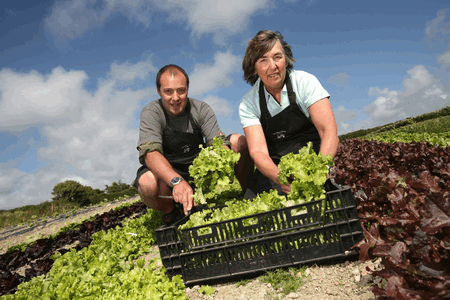
The family now delivers about 40 boxes a week to regular customers. The boxes mostly contain vegetables they have grown conventionally themselves, but these are supplemented through strong links with local producers.
Where Trevilley Farm once grew a staple Cornish mix of potatoes, brassicas and flowers, it now produces 50 varieties of vegetable for direct sale to the public. Production has inevitably become more labour intensive, but by direct selling, margins have increased. The combination of shop and box scheme means that wastage is reduced, with the boxes absorbing some of the gluts.
The Barretts are satisfied with the current level of sales, acknowledging that although their scheme is relatively small, it does promote regular custom at the farm shop.
Customer care is given high priority. Each person joining the scheme fills in a questionnaire about his or her preferences. A website allows online customers to email changes in their weekly requirements.
The boxes, on request, can also contain items from the farm shop, including the Barretts’ own beef and lamb, their home-baked bread, and outsourced eggs and dairy products. A fortnightly farm newsletter with recipes, also available online, is sent out with each order.
The minimum box order is £10, but there is no standardised price staging otherwise, as with other schemes. Because the contents of each box are customised, packing in recyclable containers is a day’s work for one person.
Delivery is made within a 10-mile radius, and distribution takes up two evenings a week. The farm has a dedicated packing shed for the boxes, and cold storage which is also used for the shop.
In addition to the home delivery scheme, Trevilley also provides Christmas hampers, produce by post, and boxes for self-catering holiday visitors, which are all advertised on their website. During peak periods, demand for their boxes approximately doubles.
Maple Farm, Suffolk
The mixed arable and livestock Maple Farm in Kelsale, Suffolk was given Soil Association certification 10 years ago, and in 2004 diversified into a vegetable box scheme.
The farm is owned by William Kendall’s wife Miranda and has been traditionally run by her family for 50 years. The farm is managed by employees, but William brings a long experience of farming, and of growing businesses in a range of sectors.
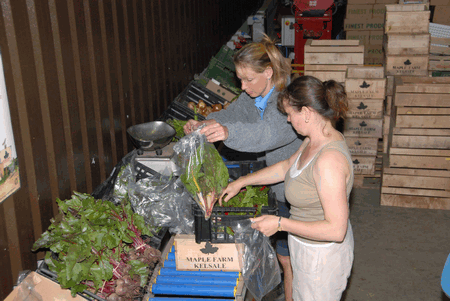
He is also committed to a principle of community sustainability, and like Trevilley in Cornwall, the farm has strong links with other local businesses.
A DEFRA grant funded some set-up costs, including a basic conveyer belt for the packing shed, and a supply of returnable wooden boxes with the farm logo, which William believes has helped with establishing the brand.
The scheme grew very fast and now delivers to 200 local, second-home and seasonal visitors, at an average rate of about 120 units a week.
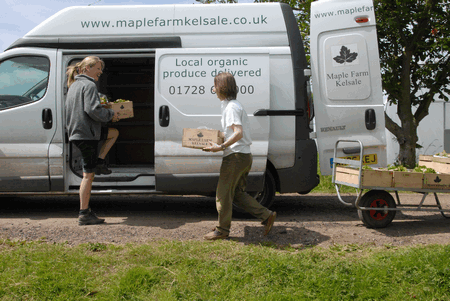
The Maple Farm team decided early on that it was neither economic nor environmentally sustainable to carry on with doorstep delivery in such a remote rural area. Instead, local retailers, farm shops and post offices are used as pick up points. These outlets take both the orders and the payments for the boxes, thus drastically cutting down on Maple Farm administration costs.
The commission on the box sales and increased customer traffic are a welcome return for local businesses.
The farm also produces its own flour, honey and eggs. These are delivered to outlets along with the vegetable boxes.
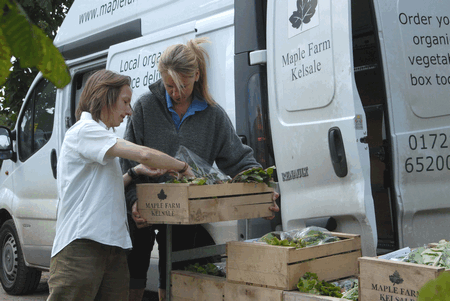
Any of this produce can be ordered by individual customers along with their box, (or for smaller households, a bag), but the vegetable contents of both are standardised. A weekly letter goes out with the boxes, which contains farm news and a recipe exchange. Farm walks are also organised.
Most of the vegetables are grown on the farm, in the fields or in polytunnels. “It would not make sense for a farmer operating their own box scheme, to do otherwise,” says William, “but no one can produce the 60-70 varieties needed, so we regularly use local producers to supplement our orders.”

Useful sources of information
- Business Link – interactive site for grant finding, also links for business advice
- Soil Association – for organic producers, but a lot of relevant information for all veg box schemes
- Vegbox – veg box listings and recipes
- Vegbox customer suvey – summary of customer feedback on veg box schemes
- Bee-Organic – story about Bee-Organic veg box collaboration with local school
- Garden organic – overview of organic box schemes
- Org prints – ADAS Wales study gives an overview of vegetable storage options for the organic market, but relevant to conventional growers
- Food hygiene business guide– a guide to food hygiene for businesses involved in the food industry
- Food farm grow hygiene– guide to food hygiene for primary growers
